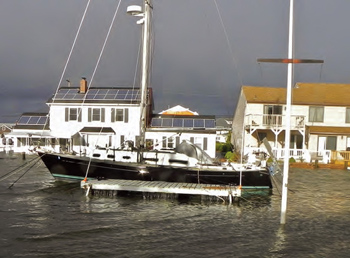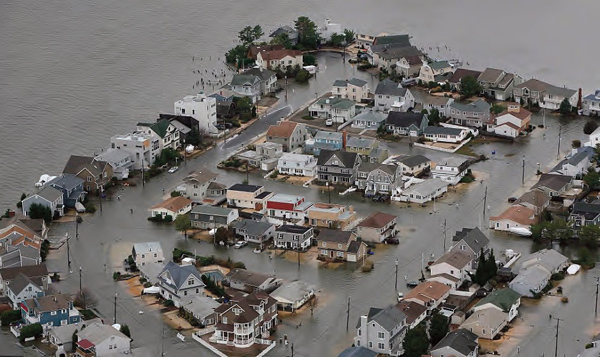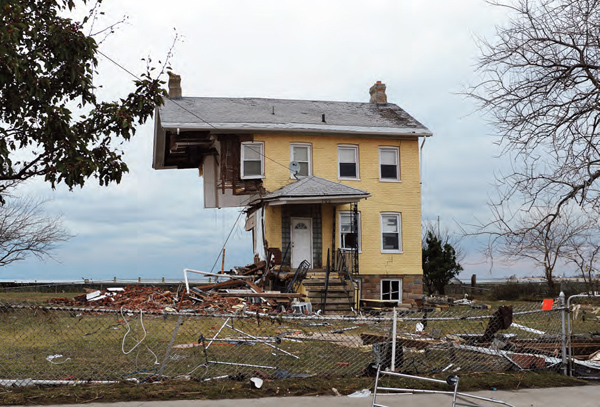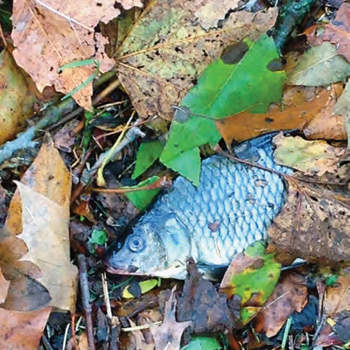SEJournal Online is the digital news magazine of the Society of Environmental Journalists. Learn more about SEJournal Online, including submission, subscription and advertising information.
Feature
By FRANCESCA LYMAN
What does Hurricane Sandy tell us about coping with human health and social consequences of climate change?
|
|
|
The Star Jet roller coaster plummeted into the Atlantic Ocean off Seaside Heights, N.J., after the Casino Pier amusement park collapsed during Sandy’s landfall on October 29, 2012. The mayor of the community now considers it "a great tourist attraction," and may seek to leave it where it is. USAF Photo by Mstr. Sgt. Mark C. Olsen, New Jersey National Guard. |
When New Jersey yacht captain Jon Eisberg heard weather reports of a tropical storm named Sandy hurtling north on an ominous path along the Eastern seaboard, he swiftly shifted course and soon headed back home to the Jersey Shore, where this tropical cyclone — now upgraded to a superstorm — was predicted to take an unexpected perpendicular left turn west, and hit within 36 to 48 hours.
Back “down the shore,” in an inlet off Barnegat Bay, a mile west of the Atlantic Ocean, the captain rode out a rattling night of high winds and pelting rain as the upper, water-whipping edge of the counterclockwise-spiraling hurricane passed over his home in coastal Brick Township. But the seasoned skipper, who’d weathered plenty of storms, Nor’easters and blizzards in his years as a charter yacht-delivery captain, was unprepared for what happened next.
|
|
|
Eisberg’s sailboat became a lifeboat when the floodwaters of Barnegat Bay forced him from his house. The morning after Sandy, the yard and bulkhead behind his Brick Township house were still submerged. Photo: courtesy Jon Eisberg. |
The Jersey shore resident had never, in his 40 years of living in this quiet tidal community, seen his home remotely close to being flooded. But hours after watching rains and storm surges pour down the road, engulfing his car and those of all of his neighbors outside, he’d see his house surrounded by a lake some five feet deep, like some sort of scene out of “Waterworld” with Kevin Costner. “I wanted to check on my own boat” (docked behind his house), he laughed, “but I would have had to swim to it.”
More strangely, beyond his boat, a moonlit cloud-mass of sky lit up with a surreal red glow. “It was very spooky and frightening, and it took me a few minutes to realize that this was the color of houses, in the distance, on fire,” he said.
Houses ablaze from broken gas mains, power outages from downed trees, homes flooded from tidal surges and/or overflowing rivers, and toxic waste spills would be just some of the immediate challenges that plagued towns and cities that came in the path of this hurricane as it barreled through.
As the floodwaters started gurgling into Eisberg’s house, he wondered if his house would survive the night.
‘This is what climate change looks like’
Sandy’s death toll of 200 and the billions in projected financial losses are only the beginning of the storm’s legacy. In Sandy’s wake, disaster-preparedness officials are learning that even a supposedly sophisticated emergency-response system like New York City’s can be overwhelmed by mega-storms that seem to be increasing in frequency.
For environmental journalists, this raises a prescient question: What can my community do to better prepare? How can my community prepare for the mental-health needs, and the other effects on human health that these storms increasingly pose?
The massive size and ferocity of this storm as it rolled up the coast raised questions in the minds of scientists as to whether it was a harbinger of the fiercer Atlantic hurricanes forecast by some to increase in this century as sea surface temperatures, storm surges and sea levels rise under climate change, as described in "America's Climate Choices: Adapting to the Impacts of Climate Change," by the National Academy of Sciences, 2010.
The consequences of Sandy will continue to unfold for years. Now that the floodwaters have receded and the toppled trees have been hauled away, residents still are dealing with profound mental and psychological stress, as well as the task of rebuilding their homes, replacing their cars and paying for it all — including doctors’ bills. Kim Knowlton, a health scientist at the Natural Resources Defense Council, says events like Sandy tell us, “This is what climate change looks like and there’s a real human health dimension to it.”
The destruction wrought by this superstorm is a timely reminder of some of the threats climate change can pose to life and infrastructure. It begs important questions as diverse as whether to continue to site houses, buildings and hospitals in flood zones, and if new seawalls can really protect us as we face more and more dangerous storms.
It is also a keen warning of the indirect impacts of extreme weather events to human health, both immediate but also longterm and chronic.
Sandy struck densely populated places where people are not accustomed to coping with hurricanes and their enormous danger.
In New York City, police were answering 10,000 phone calls every 30 minutes, about ten times the average, many because of downed trees, according to The New York Daily News. Arboreal experts from Seattle and Portland, the land of giant trees and winter storms, had to be deployed in the aftermath of Sandy to help clear downed trees and limbs.
The Jersey shore and Northeast region hadn’t seen a storm as powerful in 50 years, said Ed Gabriel, principal deputy assistant secretary at the Department of Health and Human Services, whose agency provided medical personnel with pre-staged resources like ambulances and response teams of doctors, nurses and paramedics to affected coastal communities. “They were devastated and will be affected for a long time,” said Gabriel.
“Attaching this storm to climate change, I can’t do,” added Gabriel, “but the development of a Category 1 hurricane in these flood zones, where the worst damage comes from surges,” and “affecting the elderly, people with special needs, with great vulnerability,” struck a huge toll, emotional and physical.
For weeks after Sandy, emergency medical teams were still responding in places where hospitals had to evacuate due to flooding, including several big hospitals in New York City, like NYU Medical Center and Coney Island.
Could Sandy be a harbinger of extreme weather events to come, which could become the new normal? And if so, how well prepared are American communities to cope?
|
|
|
On the day after the hurricane, the flooded Chadwick Beach Island development on the N.J. shore north of Seaside Heights looks more like Venice, as witnessed by Governor Chris Christie during a damage inspection flight. Photo by Tim Larsen, New Jersey Governor's Office. |
Even ‘prepared’ cities not prepared
The storm also drew the issue of climate change out of the political deep freeze. The words “global warming,” which had been left unsaid by both presidential candidates, were suddenly on everyone’s lips.
New York City Mayor Michael Bloomberg declared, “Our climate is changing. And while the increase in extreme weather we have experienced in New York City and around the world may or may not be the result of it, the risk that it might be — given this week’s devastation — should compel all elected leaders to take immediate action.”
Many writers and commentators noted that, while reporters and pundits avoided the words climate change, “Sandy spoke.” Was Sandy shorthand for Cassandra? — some asked.
“It’s Global Warming, Stupid,” read the headline on Bloomberg Businessweek news magazine in the week following the storm.
As the waters of Hurricane Sandy subsided, the newly re-elected President Barack Obama invoked the issue in his acceptance speech, “We want our children to live in an America that isn’t threatened by the destructive power of a warming planet.”
Observers would note later that Obama didn’t need to invoke the next generation since climate change’s effects were already happening.
“If Hurricane Sandy does nothing else, it should suggest that we need to commit more to disaster preparation and response,” read the editorial in Bloomberg.
|
|
|
Roofing blown off a Jersey City, N.J., building wrapped around a nearby statue of the Madonna. Photo: |
NRDC’s Knowlton would agree. “This was the storm that no one was prepared for — not hospitals, who didn’t have generators on upper floors and depended on critical elements on lower floors, nor [people coping with] flood waters way beyond what was expected under the maximum storm surge,” she said.
Even though New York State had been making great efforts to be “climate ready,” and had identified flood zone places in harm’s way as part of an initiative to assess “potential health issues associated with climate change,” that was not adequate during Sandy.
“Even a prepared city with forethought was not prepared,” says Knowlton. “That’s part one of the really sobering story of Sandy.”
Art Kellerman, an expert in emergency preparedness in healthcare at the RAND Corporation, said hospitals need to look at their survivability in a natural or manmade disaster. “If you asked me the one city in America that has its act together, I would have said New York,” he told Reuters. “That tells you how much trouble we’re in, in Dayton and Detroit and Sacramento.”
Many poorer neighborhoods didn’t have the wherewithal to respond, even with departments of health and mental health working full tilt, adds Knowlton. “With often heroic efforts by many health professionals and people in transportation, they helped in many places,” she said. “But we haven’t made the priorities yet for delivery to all neighborhoods in the most affected areas.”
Storm drives home human health issues
To be sure, the hurricane was deadly to homes and property, damaging hundreds of thousands of vehicles, for example, especially in New York and New Jersey, and inflicting some $70 billion in damage in those states alone. Hundreds of thousands of Connecticut, New York and New Jersey residents registered for housing assistance and other help, while within weeks of the storm FEMA had approved state assistance of some $500 million.
However, it also drove home a variety of human health issues that relief workers, volunteers and survivors had to contend with in thousands of communities hit by a late-season storm. One of the first was the possibility of more storms, as another Nor’easter hit a few days later, with snow and cold that put people at risk of colds and fevers, prompting warnings from authorities to find warm shelter.
Health and Human Services’ Ed Gabriel said that the storm surges brought a “surge of patients” out of flood zones who would end up in hospitals and shelters outside their neighborhoods, or in “MASH” tents set up to serve them. For this storm, said Gabriel, there were 2,300 emergency federal medics and assistants deployed, ten times the number initially called upon. “That’s a large number,” he said weeks after the storm. “We’re still in the midst of responding so it’s hard to say, but I’d guess it’s bigger than Katrina.” The sheer geographic spread of the hurricane across a dozen states made it a standout among storms.
As the recovery effort proceeded in states most affected, federal and state agencies would be faced with growing problems of toxic or noxious substances, like oil, chemicals and raw sewage that the storm discharged into waterways, and the mold left behind in flooded or water-damaged homes and buildings.
Community activists and volunteers with churches often stepped into the breach, as detailed in “Occupy Sandy,” a documentary chronicling ordinary people grappling with the mess left in coastal areas, with boats washed up against houses, beaches ravished and houses filled with water damage, smells and mold.
“Everyone had this cough, which could have been from the mold and the septic that washed up, or exposure to all the gasoline and hydrocarbons in the water and air,” says Josh Fox, documentary film maker and author of “Occupy Sandy,” as well as “Gasland,” a film about natural gas hydraulic fracturing, or “fracking.” “It actually reminded me of the many people suffering from sinus infections and other ailments, like ringing ears, in fracking areas.”
Warning clean-up workers and ‘refugees’ from their flooded homes in affected areas, labor activist Vincent Alvarez, president of the New York City Central Labor Council, issued tips for staying safe in the weeks of recovery that followed the hurricane.
“There is a wide range of hazards to which workers, volunteers and home owners may be exposed,” Alvarez said, pointing to such diverse perils as electrocution, asphyxiation and exposure to toxic substances. Besides mold and bacteria, also of concern in many flood locations, are asbestos, lead and silica.
Another labor leader, John Durso, president of the Long Island Federation of Labor, recalled past emergency events like the terrorist attacks at the World Trade Center, Hurricane Katrina and Deepwater Horizon, where “there were significant gaps in responding to emergency worker and volunteer health and safety needs, resulting in tens of thousands of rescue and clean up workers becoming ill.”
Flooded areas along the Gowanus Canal, a federal Superfund toxic waste site, and Newtown Creek, where sewage overflowed with storm water into nearby residential areas, posed significant threats to human health, said Joel Shufro, director of the New York Committee for Occupational Safety and Health.
|
|
|
Hurricane Sandy was powerful enough to sweep away half of this brick house in Union Beach on northern New Jersey’s Raritan Bay, including its masonry foundation, but curiously left undisturbed a satellite dish affixed to the roof of the building’s porch. Photo: |
Vulnerability to extreme weather
What Sandy is telling us about the public health consequences of extreme events in a climate-changing world goes far beyond such immediate details, however.
“People often get hung up on the question about how much climate change influenced Hurricane Sandy,” says Daniel G. Huber of the Center for Climate and Energy Solutions, “but the clear overriding message from Sandy is our vulnerability to extreme weather and natural variability as well,” whatever that environmental condition might be.
Storms and floods are just one aspect of the many impacts of climate change predicted to affect human populations with greater frequency and greater intensity, according to the Intergovernmental Panel on Climate Change (IPCC).
Droughts and heat waves, like those record-breaking temperatures seen across the United States last summer, are another. There’s a huge assortment of health impacts of climate-change induced extreme-weather events that researchers have been studying, primarily those related to heat waves, droughts and infectious diseases transmitted by changing insect and animal migrations.
As Superstorm Sandy bore down on North America’s east coast, the United Nations issued a reminder that storms and floods are just one side of the climate change coin — citing the possibilities that heat and cold waves, tropical cyclones, floods, droughts, other natural hazards can cause tens of thousands of deaths and hundreds of thousands of injuries globally each year.
Among the findings of a newly released U.N. report was that the likelihood of increasingly frequent heat waves hitting the planet would be 4 to 10 times as often by 2050 as today; the study also found that these impacts would be felt most strongly in the fast-growing vulnerable populations of aging and urban people, particularly in Africa, the Middle East and Asia.
“Many diseases including malaria, dengue, meningitis — just a few examples — these are what we call climate-sensitive diseases, because such climate dimensions for rainfall, humidity and temperature would influence the epidemics, the outbreaks, either directly influencing the parasites or the mosquitoes that carry them,” said Dr. Margaret Chan, the director-general of the U.N. World Health Organization.
However, these real human health concerns often get sidelined in big international debates over climate change, where the focus is on melting Arctic sea ice, sea level rise, or larger environmental questions where the effects on humanity aren’t so clear.
“Sandy has illustrated how narrow our view is of the real human impacts of extreme weather events,” said Katharine Hayhoe, a climate scientist at Texas Tech University in Lubbock, Texas. Hayhoe charged that researchers looking at the intersection of public health and climate typically focus on the more direct impacts of global warming, such as heat stress, respiratory diseases from air pollution and infectious diseases like West Nile Virus and hanta virus. But they ignore bigger indirect impacts, like infrastructure disruptions in electrical power, gasoline, water, food, etc.
If we continue to see flooding as a “low-probability, high impact” event rather than a real risk to us in the future, with the doubling of category four and five hurricanes forecast by climate scientists, Hayhoe said, we’ll fail to adequately realize the price tag in human terms and adequately prepare for, or prevent, such forecasts.
‘A threat to the human race’
Sandy should make us much more sympathetic to the kinds of flooding episodes that routinely plague the developing world in places like Pakistan and Bangladesh, Hayhoe said. “If we knew what was coming, we’d be wishing for a few mosquito bites.”
In December, at the deadlocked climate change talks at Doha, Qatar, U.N. Secretary-General Ban Ki-moon said the extreme weather was becoming “the new normal and poses a threat to the human race.” In a speech to almost 200 nations meeting in Qatar, he cited record thaws in Arctic sea ice, superstorms and rising sea levels as “all signs of a crisis.”
Today, Jersey Shore boat captain Jon Eisberg’s shore community still looks like a disaster zone. Weeks after the storm, his neighborhood has been cleared of some of the worst damage — boats thrown off their moorings, floating debris. But, says Eisberg, there’s still mud everywhere.
“The storm surges brought an ungodly amount of mud, and whatever was suspended in the water when the water receded,” he said. People joked that “Sandy” should be renamed “Muddy.” Even that’s a euphemism for the often-toxic “sludge,” smelling of gas fumes, chemicals and bacterial odors.
“If Hurricane Sandy does nothing else, it should suggest that we need to commit more to disaster preparation and response,” read the editorial in Bloomberg.
|
|
|
A fish out of water — a post-storm fall foliage still life captured in a Long Island, New York front yard with a smartphone camera. Photo: |
Eisberg was lucky. The day after, he was able to wade to his “escape pod,” his beloved 30-foot sailboat “Chancy,” which had weathered the storm without a scratch, floating happily on water, and fully outfitted with power, warmth and stores of food. He was off the grid with solar panels and a wind generator on hand for the long haul, if the power wasn’t restored.
Eisberg considers himself fortunate compared to many of his neighbors who either lost houses to the sheer force of the storm, or escaped with their lives as they retreated to attics, left marooned by flooded cars. His elderly neighbors Betty and Bob lost their home on Barnegat Bay to raging five-foot waves, something unthinkable before Sandy. “How do you come back from that in your mid-seventies?” Eisberg asked.
Thankfully, he was far enough away from the peak waves that came at the same time as a full-moon high tide, with storm surges that swept over barrier beaches, destroying beach homes, devastating bridges, piers and roads, and re-carving the coastline.
“Events like Sandy really make us aware of our sense of vulnerability and our dependency on systems that we have little control over,” he said.

Francesca Lyman is a journalist and author of The Greenhouse Trap, with World Resources Institute, and Inside the Dzanga Sangha Rain Forest. She has covered global warming for magazines since 1984, when her research on sea level rise and storm surges led her to hydrologists in the Carolinas who forecast the kinds of effects seen with Hurricane Sandy. A panel discussion at the SEJ 2012 annual conference in Lubbock, Texas, on Climate Change and Public Health led to this article. She can be reached at chicha19@comcast.net.
* From the quarterly newsletter SEJournal, Winter 2012-13. Each new issue of SEJournal is available to members and subscribers only; find subscription information here or learn how to join SEJ. Past issues are archived for the public here.











 Sharla Sava via Flickr.
Sharla Sava via Flickr.





 Advertisement
Advertisement 



